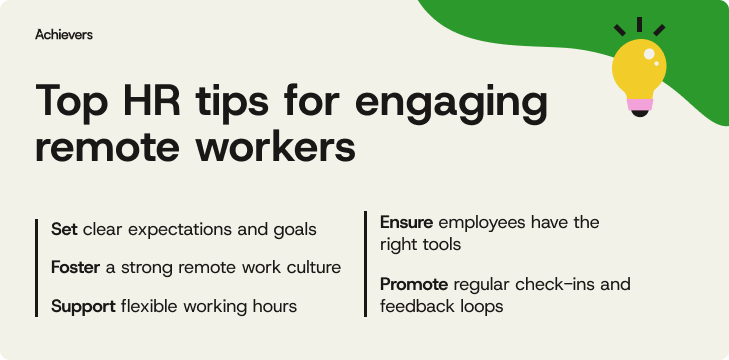Table of contents
Create a culture that means business™
Schedule a demo with an Achievers solution expert today.
Over the past few years, remote work has evolved from a temporary fix into a long-term reality for millions of professionals. In fact, approximately 27% of U.S. employees now work remotely full-time. And while flexibility has its perks, it also brings a unique set of challenges — think blurred work-life boundaries, digital fatigue, and a lack of spontaneous connection.
That’s why keeping remote teams productive and engaged is essential. When employees feel supported and connected, performance, culture, and retention all improve.
In this blog, we’ll share 20 actionable remote work tips to help remote employees stay focused, motivated, and connected — so your teams don’t just work remotely, they thrive remotely.
20 tips to engage remote workers as an HR professional
Engaging a dispersed workforce doesn’t happen by accident — it takes intentional strategy and a people-first mindset. From empowering autonomy to creating space for connection, here are 20 actionable tips HR professionals can use to boost productivity, morale, and belonging in any remote or hybrid workplace:

1. Set clear expectations and goals
Vague goals lead to vague results. Give employees a solid runway by setting SMART goals — yes, the acronym is old, but it works. When people know what’s expected (and by when), they’re more likely to hit the target — and less likely to spend half the day deciphering vague Slack messages.
2. Foster a strong remote work culture
Culture doesn’t clock out when people work from home. Reinforce your values digitally and build team rituals that remind people, “Hey, we’re in this together.” Whether it’s a Monday meme drop or a monthly toast over Zoom, remote teams need shared moments — especially when the break room is now their couch.
3. Ensure employees have the right tools
You wouldn’t expect someone to win a race without shoes — so don’t expect productivity without the right tech. Invest in collaboration platforms and offer stipends for home setups. Bonus points if IT support doesn’t take three days. Friction-free tools make remote work, well… work.
4. Promote regular check-ins and feedback loops
Silence isn’t golden when your team’s remote. Weekly one-on-ones give employees a chance to share, vent, or celebrate. Add pulse surveys to keep your finger on the culture’s pulse (pun intended). Consistent feedback beats an annual review any day of the week.
5. Support flexible working hours
Let’s be honest: productivity doesn’t only happen between 9 and 5. Give employees the freedom to structure their workday. As long as the job gets done, does it matter if it’s fueled by a 6 a.m. espresso or a midnight brainstorm? Outcomes > hours. Always.
6. Encourage time management strategies
Working from home means your kitchen becomes both a snack station and temptation central. Help employees create structure with tools like the Pomodoro method or time-blocking. Offer resources that turn chaos into calendarized calm. Because sometimes, “I’ll just check my email” turns into three hours and 47 tabs later.
7. Establish clear communication guidelines
Define the difference between “urgent,” “non-urgent,” and “please don’t ping me at 10 p.m.”. Set rules of engagement for email, chat, and meetings, and put everything in a searchable hub. Clear beats clever — especially when half the team is in pajamas and the other half is 10 time zones ahead.
8. Recognize and celebrate achievements
Employee recognition shouldn’t be reserved for just award shows or annual town halls. Celebrate wins regularly, publicly, and creatively. Whether it’s a kudos channel, peer shoutouts, or a platform that makes recognition part of the daily flow — make appreciation a habit, not a headline.
9. Prioritize mental health and well-being
You can’t pour from an empty cup — especially when the cup is running five Zooms deep. Offer access to mental health tools, encourage real lunch breaks, and talk openly about burnout. Employee wellness shouldn’t be whispered about. A healthy team is a high-performing team (and a lot more fun to work with).
10. Promote social connections
Let people be more than job titles. Schedule low-pressure social hangouts — virtual trivia, coffee chats, or even “bring your pet to Zoom” days. Create Slack channels for hobbies, memes, or fans of oddly specific TV shows. Connection fuels collaboration — and laughter never hurts either.
11. Offer opportunities for professional development
Remote shouldn’t mean stagnant. Support growth with online learning stipends, internal workshops, or access to courses. If someone wants to master Excel macros or finally understand blockchain (good luck), give them the tools to do it. Development today leads to loyalty tomorrow.
12. Ensure fair and transparent career progression
Nobody likes career mysteries. Lay out clear paths for growth, define criteria for promotions, and run virtual performance reviews that aren’t just polite nodding over Zoom. When employees understand how to move forward, they’re more likely to stick around for the journey.
13. Create a remote-friendly onboarding experience
Onboarding shouldn’t feel like being dropped into a Slack channel and told, “Good luck.” Create a structured, warm welcome with guided tours, starter resources, and a buddy system. Remote doesn’t have to feel distant — just intentional.
14. Address remote work isolation proactively
Out of sight shouldn’t mean out of mind. Make space for team members to share wins, frustrations, or “my cat walked on my keyboard again” moments. Try virtual co-working sessions for quiet accountability. Being remote doesn’t mean being alone.
15. Encourage movement and ergonomic best practices
Slouching is not a strategy. Share tips on good posture, wrist support, and why balancing your laptop on a pillow isn’t sustainable. Run wellness challenges or stretch breaks. Healthy bodies help power sharp minds — even if it starts with a better chair.
16. Support employee resource groups (ERGs)
ERGs are more than buzzwords — they build belonging. Help launch and support groups for shared identities or interests, and back them with real resources and leadership support. These spaces create community, amplify voices, and make your company culture more inclusive — even through a screen.
17. Make meetings more engaging and effective
Spoiler: not every meeting should be a meeting. Embrace async updates and cancel when a Slack message will do. For the rest, keep them short, interactive, and — dare we say — fun. Add polls, Q&As, or even the occasional icebreaker. Zoom fatigue is real. Let’s not add to it.
18. Offer incentives for engagement and performance
Give credit where credit’s due — and throw in some perks while you’re at it. Spot bonuses, gift cards, or reward points go a long way. Gamify milestones if that fits your culture. When effort is seen and rewarded, motivation skyrockets (and so does retention).
19. Solicit regular feedback from employees
Feedback isn’t a favor — it’s a necessity. Ask for input through surveys, open forums, or anonymous forms. More importantly, act on it. People will speak up if they believe someone’s actually listening — and doing something about it.
20. Lead by example
Remote culture is built at the top. Leaders should model transparency, take breaks, recognize effort, and show up authentically — yes, even if their kid walks into the background mid-call. When leaders lead like humans, it gives everyone else permission to do the same.
How Achievers helps keep remote employees engaged and connected
Even the most thoughtful remote work policies need the right tools to bring them to life. That’s where Achievers comes in. Our platform helps HR leaders, managers, and more support, recognize, and engage remote teams at scale — with features built to connect people, spark motivation, and turn insights into action.
Here are just a few of the fun things we offer:
Recognition and rewards
Working remotely shouldn’t mean working in a vacuum. With Achievers, recognition is just a click away — whether it’s a manager giving kudos for a big win or a colleague shouting out a behind-the-scenes hero. And because points turn into real rewards, motivation stays high (and swag drawers stay full).
Employee feedback and engagement insights
You can’t fix what you can’t see. Achievers captures real-time feedback from employees, so HR teams aren’t guessing how people feel — they know. With AI-powered insights, you can spot trends, flag concerns, and make smart moves to boost engagement before problems become exit interviews.
Build a thriving remote
Build a thriving remote workforce
Engaging remote employees isn’t rocket science — but it does require intention, consistency, and the right tools. From setting clear goals and encouraging flexibility to recognizing great work and gathering real-time feedback, the remote work tips we’ve covered are your blueprint for building a remote culture that actually works.
Because when employees feel supported, seen, and celebrated — no matter where they log in from — they don’t just stay productive. They stay loyal, motivated, and ready to bring their best.
Looking to bring all these strategies together in one platform? Achievers makes it easy to recognize, reward, and retain your remote workforce at scale. Explore how our employee experience platform helps you shape the behaviors that drive results (and maybe even a few happy dances along the way).



